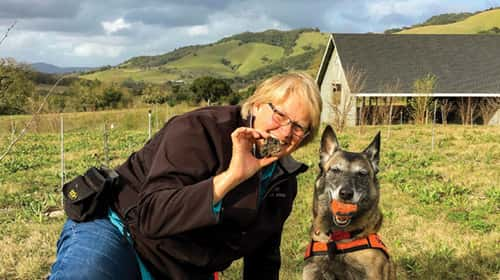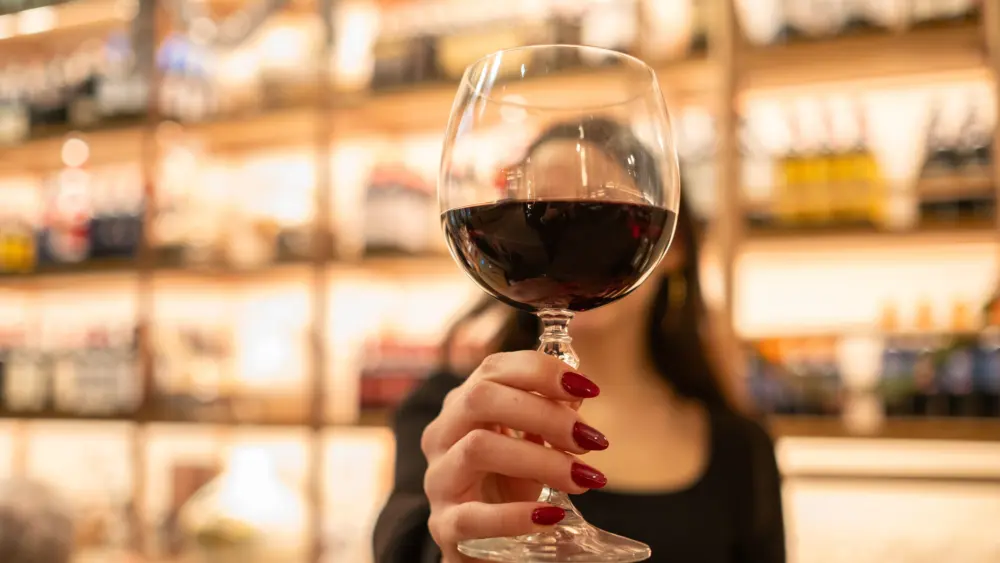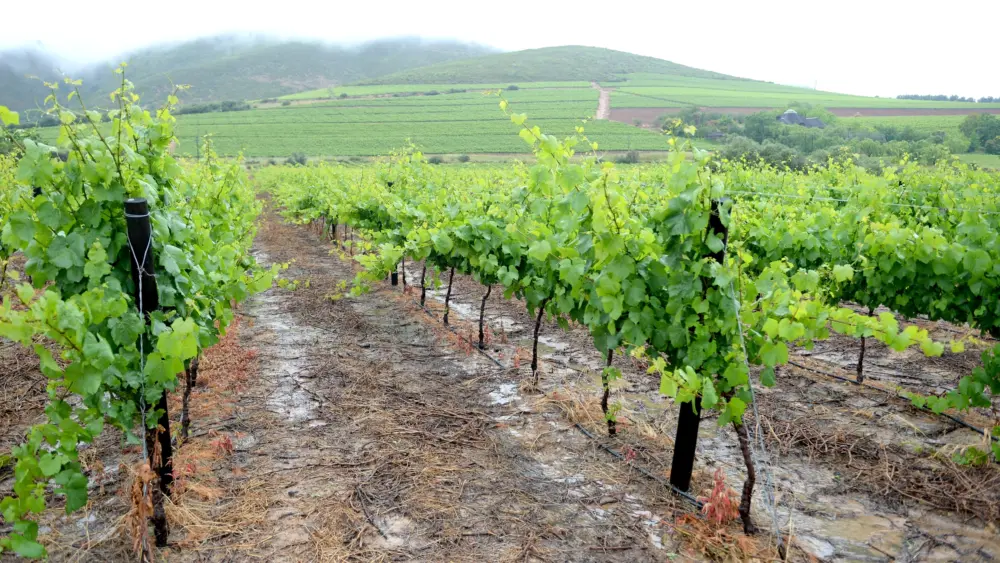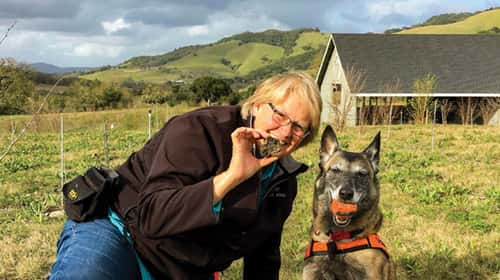 In February 2017, a dog named Ilsa discovered the first-ever cultivated European Tuber melanosporum, or the Périgord truffle, in Sonoma County.
In February 2017, a dog named Ilsa discovered the first-ever cultivated European Tuber melanosporum, or the Périgord truffle, in Sonoma County.
“Ilsa and her owner, Kris, are a pretty special team,” says Todd Spanier, owner of King of Mushrooms and founder of California Truffle Orchards LLC. “Other teams tried to find Périgord in Wine Country before, but they hadn’t come up with anything until now. It’s a challenge enough to grow these valuable truffles, but to find them requires a special nose and an expert trainer.”
“Ilsa is a Belgian Malinois who is just one in a million,” says Kris Jacobson, owner of Ilsa and Umami Truffle Dogs LLC.
The two have worked together for a number of years in the burgeoning truffle industry and are pioneers in the field, being credited with numerous first-ever Périgord truffle discoveries along the West Coast.
Black truffles from the Périgord region of France are considered one of the most sought-after and expensive truffles in the world. Historically, they are found in the wild using trained pigs or dogs to find them because, unlike other fungi, they grow underground at the base of hazelnut and white oak trees. And though many species of native truffle grow in America, it is the Périgord that are prized for their intense aroma and flavor.
“Ilsa and I have found a lot of cultivated Périgord truffles in Oregon the last three years,” says Jacobson. “But when Todd asked that I go to California and look for them in Wine Country, I was skeptical because other dogs had routinely been searching Wine Country truffieres without success. But Todd is a special guy and an ethical and honest man in an industry that occasionally attracts less-than-honest individuals, so I agreed to travel south. The day we arrived at KJ, Todd had been trying to get in touch with the folks at KJ, but they weren’t returning his calls or text messages. When we drove to the gate, he kept calling until he reached someone.”
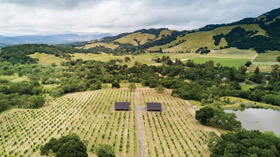 In 2011, Jackson Family Wines planted nearly 10 acres of hazelnut and white oak seedlings, all inoculated by New World Truffieres in Oregon with spores from the Périgord truffles. Since then the orchard has been farmed by Brian Malone.
In 2011, Jackson Family Wines planted nearly 10 acres of hazelnut and white oak seedlings, all inoculated by New World Truffieres in Oregon with spores from the Périgord truffles. Since then the orchard has been farmed by Brian Malone.
“I was mortified by Todd’s persistence, but finally Brian, the vineyard manager, called back, and agreed to let us search the orchard,” says Jacobson. “I was even more mortified when we reached the orchard and I saw how immature the trees were. I thought, I don’t want to do this; this orchard is too young and this is never going to work. But Todd stayed with Brian and talked to him, allowing Ilsa and I to go to work without any distractions. It’s kind of a dance we do together—she focuses on searching for the truffle scent, and I watch her for the slightest change in body language. I also need to direct her to search in a special pattern that takes into account numerous factors that have been key to our success. We can’t be distracted while we work.”
“Seeing those two work together is like nothing I’ve ever witnessed before,” says Spanier. “It’s as if they’re performing an intricate dance. Complete professionals. I knew if anyone would find truffles there, it would be them.”
The day was overcast with puffy rain clouds and sparse patches of blue sky. The dog and her reluctant trainer went to work.
“We were there for 10 minutes, and lo and behold, Ilsa lowered her head and I’m thinking, she’s on to a truffle, but I am not 100 percent she is on the scent of the Périgord. Even so, I was getting excited,” says Jacobson.
The dog sniffed at the ground and then looked up. By her excitement Jacobson knew it meant a Périgord.
“I watched her as she started going back and forth in a very focused manner with her tail wagging and her demeanor became very excited,” she recalls. Jacobson knew she was on the scent of a truffle. “I watched her, clearly following the scent straight to one of the trees and then she lightly touched the ground with her nose and a paw, then sneezed and looked up at me. “This is how she ‘alerts’ and communicates to me that she has found a truffle and it’s her way of communicating to me the truffle is in this exact spot. I went to the place where she alerted, knelt down, smelled the earth, and immediately knew Ilsa had found a Périgord truffle. The aroma was unmistakable.”
When Jacobson called over Todd and Brian, they all stood looking down at the ground in amazement.
“There were a some four-letter words coming out of our mouths,” says Jacobson. “I can’t explain the amount of excitement. This was historic and we all knew it. This whole truffle industry is young and unproven on the West Coast. This was a big deal, not only for KJ and Todd, but for Ilsa, who had also found the first Périgord in Oregon four years earlier, as well as other first Périgord finds for several Oregon truffle orchard owners and now we found not one in Wine Country, but a whole bunch of them. There simply is no other dog out there who can do what she can do.”
By the end of the day, their search uncovered 17 of the precious fungi, the total take weighing a whopping 1.5 pounds.
“We are tremendously excited with the results of this experiment. We’ve been waiting patiently to see if our hunch and hard work would yield results,” says Barbara Banke, chairman and proprietor, Jackson Family Wines. “The quality and quantity of the truffles exceeded my expectations.”
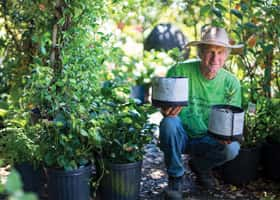 California truffle production
California truffle production
“This is a significant breakthrough for new-world truffles and presents a new agricultural opportunity for Wine Country,” says Charles Lefevre, founder of New World Truffieres in Eugene, Ore. Lefevre sold the inoculated seedlings to Jackson Family Wines and has also supplied inoculated trees for about 100 orchards in Wine Country, and somewhat more along the Pacific Coast—most of which are still young and have yet to produce a harvest. Beyond selling the trees, Lefevre helps guide his clients in their orchard-management practices.
“There was already a lot of activity in Sonoma County before Jackson Family Wines’ orchard produced truffles, but this breakthrough has given all of the local growers a renewed sense of optimism,” Lefevre said. “New growers are responding with greater determination and willingness to invest in the management of their orchards.”
Farmers interested in truffle cultivation need to know it can take years to see results. Truffle cultivation is still new to North America, and it can take five to eight years for truffles to grow. Many hope that Wine Country’s climatic similarities with truffles’ native homes, such as France’s Périgord, could make it a prime destination.
The tipping point for truffle production in Wine Country?
“I couldn’t be happier with the activity I’m seeing,” Lefevre said. “There are several large, well-managed truffle orchards in Sonoma County and elsewhere in Northern California that I expect to begin production within the next couple of years.”
Beyond sourcing inoculated trees that are well-colonized by the truffle fungus, the quality and management of the site make all the difference.
“Jackson Family Wines has a good site with well-drained and well-structured soils and sufficient irrigation water,” Lefevre explains. “It’s good farm land, and there is a lot of it in Sonoma and Napa counties. They also planted good trees that were well-colonized by the truffle fungus, and they followed my instructions for site preparation and installation of their irrigation system. None of that is unusual. The difference is that Brian Malone, the Jackson Family Wines orchard manager, is a skilled and knowledgeable professional, and he devotes a great deal of personal attention to the management of the orchard.”
But cultivated truffles are not exactly new to California.
The first California truffles
The first successful grower of Périgord truffles outside of Europe was the late Bill Griner, a secretive farmer in Mendocino who sourced his trees from a French native, Francois Picart, who lived in Santa Rosa, according to Lefevre. Griner planted trees in 1982.
“Bill had a small orchard in the backwoods near Laytonville in Mendocino County that produced its first truffles in 1987,” says Lefevre. “The orchard continued to produce a lucrative crop through 2007, when he died. Because it was so remote, the orchard was abandoned after his death, but the property was recently sold and the new owners have expressed interest in revitalizing the truffle project.”
“Back in the ’80s and ’90s few were thinking about cultivating truffles besides Bill,” says Spanier. “Bill was one of my biggest influences and a real pioneer. He was the founder of Mendocino Black Diamonds and the first to successfully produce commercial quantities of truffles on his small, secluded orchard. I first met Bill at the San Francisco Mushroom Festival in the early 1990s and later bought and sold his local truffles.”
“With the Jackson Family Wines orchard, there are now four truffle orchards in California that have produced the Périgord truffles,” says Lefevre. “The first, Bill’s, proved the concept that truffles could be farmed outside of their natural habitat. The other three are my customers, with orchards near Placerville, Madeira and now in Sonoma County.”
Beyond truffle orchards within California, there are successful farms around the country.
“My company works with truffle growers throughout the U.S. and southern Canada,” says Lefevre. “The hot spots around the country in addition to Northern California are Oregon, Idaho, Kentucky, Tennessee, Virginia and North Carolina, and we have customers here and there in nearly all of the contiguous states. About a dozen of our customers have started producing their first truffles, and just this year we saw five orchards in Oregon, Idaho and British Columbia cross the threshold into positive cash flow.”
“Napa and Sonoma have good climates for cultivation of European truffles,” says Lefevre, highlighting that the cooler Sonoma coast might be better suited for Burgundy truffles (Tuber uncinatum) and the inland sites better for the black Périgord truffles.
However, like wine grapes, those farmers who want to produce the best products must farm their orchards meticulously.
“Growing truffles is just farming,” says Lefevre. “There is no mystery, no x-factor, or missing ingredient. It just requires attention to weeds, pruning, pests, nutrients and the normal stresses that farmers cope with every day. Also, while it is new in this country, truffle farming is well established elsewhere, and the black truffles from France are essentially a domesticated crop at this point.”

Cultivation
“Working with large growers is rewarding, but I also love helping out anyone who just wants to grow one tree and see if they might harvest truffles someday,” says Spanier. “So I’ve been working with local nurseries to provide them single trees that have been inoculated with truffle spores.”
“We’re finding that some people love the idea of growing their own truffles,” says Kevin Sadlier, co-owner of Green Jeans Garden Supply in Mill Valley, California. “Customers can purchase one of these two-year-old oaks and plant them in a large pot on their deck. Who knows, a few years [later], they might be slicing their own truffles over their pasta at home.”
Beyond being of interest for those with culinary proclivities, growing truffles can provide a broader message about the health of ecosystems.
“Many people don’t understand the synergistic relationship that truffles have with the trees and the broader environment,” says Xander Wessells, Sadlier’s wife and co-owner of Green Jeans. “The trees and fungi exchange nutrients and moisture, and the truffle provides the tree with nutrients that the tree can’t otherwise obtain. And then, in the wild, an animal in search of food finds and digs up the truffle, and then carries it off, allowing the truffle spores to spread to other locations where the cycle might begin again. The reason truffles smell so good when they’re ripe is so this natural cycle might continue.”
Selling truffles
“Périgord truffles can retail for about $950 to $1,250 per pound, and productive farms can get anywhere from 35 to100 pounds per acre, which makes them a very lucrative crop,” says Spanier. “The estimates are that the U.S. market for truffles is around $100 to $350 million annually.”
“Prices have been steady for the past few years,” says Lefevre. “The supply of truffles has declined exponentially over the past century, and it remains a small fraction of historic levels, but the modern method of truffle cultivation has brought an end to the decline, and although I have not seen hard data, I suspect that the global supply is once again increasing. However, unlike the early 20th century, demand is now global, as well, and it seems very likely that the potential demand for truffles is dramatically larger than the historic supply.”
Chefs find the truffles’ alluring and look forward to local sources.
“We can’t wait to have fresh truffles from local sources,” says Ben Balesteri, chef at Poggio’s in Sausalito. “Truffles add a whole new dimension to the culinary experience — and the fresher the better. Most truffles that come from Europe were harvested days ago, but three to five days, a week, max, is about how long they stay at their peak.”
“It’s the unique flavor/aroma combination that makes truffles so special,” says celebrity Chef Douglas Keane (formerly of Cyrus and currently co-owner and chef at Two Birds One Stone in St. Helena). “I think it’s great that they are now being cultivated locally. It takes someone with the vision like Barbara Banke to be willing to take a risk on an investment like that. Plus, anything that gives dogs more jobs is a great thing, too.”
Keane is not only a world-renowned chef but also founder of the Green Dog Rescue Project, a non-kennel dog rescue center in Windsor, California.
“A lot of truffle is about the smell, so the fresher the better,” Keane explained. “When the Australian truffles hit the market they were decent, but within two years I felt the aroma was actually stronger than the French ones.”
“Truffles have a very short shelf life,” Lefevre said. “Their peak aroma only lasts for a few days, so by the time truffles get to the West Coast from Europe they are often past their prime. This is the principle reason why locally cultivated truffles are so coveted.”
Like Balesteri, having fresh Périgord is wonderful, but Keane dreams of one day having white Italian Alba truffles locally, too.
“Now, if we could find the white ones here then I would be really excited,” says Keane.
“Local white Italian truffles—put that on the wish list,” Balesteri said.
Unfortunately, as both chefs know, Alba Italian truffles are the most expensive fungi on the planet. The highest price known to have been paid for a single white truffle was nearly $500,000 for a 2.8-pound specimen found in 2010, but they have never been successfully cultivated in Italy or any other place.
Though not something that is being cultivated, these Alba white truffles also have had a big influence on Spanier, into whom his godfather, Giovanni Tempesta, a professor of the Italian language program at Stanford University, instilled his love affair with truffles.
“He brought to class an Alba white truffle and showed us a slide show of him and his brother’s big white pig that they would walk up into the forest with from their home in Perugia, Italy, in search of these culinary treasures,” says Spanier.

The future of Wine Country truffles
“We’re just at the beginning of truffle cultivation in California,” says Spanier. “It’s like the wine industry was just starting out and people in Europe and even locals couldn’t believe that we might be able to grow European varieties of grapes and produce wine at a world-class level. Of course, that turned out to be wrong, and the same thing seems to be happening with truffles.”
“It’s sort of like when wineries started and France was laughing at us,” says Jacobson. “And like with wine, with blind tastings the truffles from our area often beat those from Europe. The future for west coast truffles is bright, and though these current truffle farming pioneers are planting and cultivating orchards now are taking risks, some are already seeing rewards, too.”
“Like so many of the wine grape growers of 50 years ago, the truffle farmers of today are the pioneers,” says Lefevre. “They’re the visionaries and the dreamers, and they are laying the foundations of this industry without the benefit of people all around them who have already done it successfully. They’re hesitant at times to devote as much effort as they should to the management of their orchards, while at other times they’re trying novel approaches that may not produce the results they want. In 50 years, truffle-growers in North America will look back and recount all of the mistakes they made, just as grape-growers do now. In that sense the truffle industry is developing normally. The proof of principle is completed, and with time and concentrated effort the truffle cultivation industry in North America will gradually mature. I do believe that the development of the wine industry over time provides a useful template to help us understand how the truffle industry will develop.”
Author
-

Tim Carl lives, writes and teaches in Calistoga. He grew up in St. Helena and traces his Calistoga grape-growing roots back five generations. You can reach him at tcarl@northbaybiz.com.
View all posts


